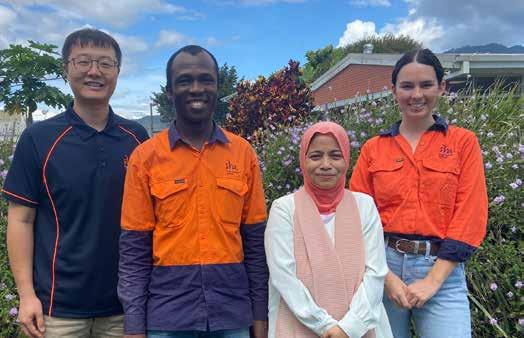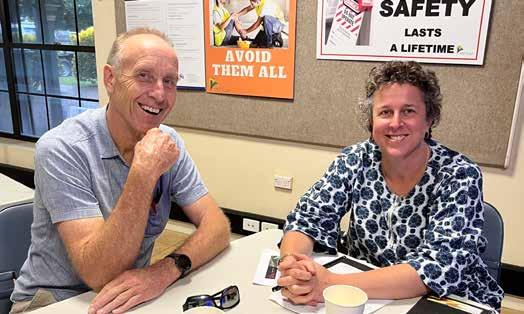
4 minute read
OUR PEOPLE
Sugar Research Australia is a critical part of the Australian sugarcane industry but couldn’t achieve any of its important research goals for the industry without attracting the right people.
Two new researchers have been welcomed by the SRA team this quarter - Research Entomologist Dr Chandrima Emtia and Leader Field Pathology Dr Seona Casonato. Both have travelled from overseas to work for SRA in Far North Queensland.
Advertisement
New Expert Joins Entomology Team
Dr Chandrima Emtia graduated from Bangladesh Agriculture University. She has experience in research and academia in Bangladesh and Japan, and is now calling Australia home.
Appointed to the position of SRA Entomologist in May, Emtia will work with SRA Entomology Leader Dr Kevin Powell and his team based at SRA’s Meringa Station, Far North Queensland.
“This is my first time in Australia,” Emtia said. “And I love it already. The people have been so welcoming, and the landscape is so beautiful.”
While this is all a bonus, Emtia says she was attracted to the role because of the work the team is doing.
“An entomologist friend in Australia sent me the link to the advertised job,” she said.
“Reading SRA’s website, I was excited by the work Dr Powell and his team are carrying out.
“SRA is balancing ways to combat local insects, species that are already established, while at the same time looking at biosecurity concerns. I believe this is the main target for the whole world," Emtia said.
“I knew this role was not only a great opportunity for me, but with my experience I could contribute to the work.”
Before joining SRA, Emtia’s post-doctoral research at Saga University, Japan was the ‘Conservation and enhancement of natural enemies for the control of complex insect pests’, This was followed by research on ‘Core technology innovation of migratory insect pests,’ at the National Agriculture and Food Research Organisation (NARO), Japan.
“We need to understand how migratory insect pests might impact agriculture,” she said.
“In addition we need to know how they occur, if they have an alternative host, any habitat manipulation strategies, and most importantly how we can control them.”
Emtia’s career began as a lecturer at Bangladesh Agricultural University. Promoted to Associate Professor in Entomology, her research mainly focused on integrated pest management of pulse beetles, work she continued in Japan: “studying the effect of insecticides on natural enemies which we knew to be toxic to both those beneficial insects and the ecosystem,” she said. Emtia also researched hoverflies for biological control of aphids during her post graduate studies at the University of Miyazaki , Japan.
“Aphids cause all sorts of damage to crops,” she said. “Until recently, lady beetles were thought to be the number one biological control method, in terms of predators. But we found that hoverflies are an earlier colonizer, and therefore, have a greater impact on aphids than the lady beetles.
“This turned the tables on research being carried out by entomologists who were looking to establish biocontrol using lady beetles,” Emtia said. “It has also opened up new pathways for control of aphids.”
“I hope with the knowledge and professional experience I have gathered in Bangladesh and Japan, I will be able to contribute to the work Dr Powell and his team are already doing at SRA. And I can learn from their experience and wealth of knowledge while contributing to the Australian sugarcane industry,” she said.
... AND NEW LEADER FIELD PATHOLOGY
Pathologist, Dr Seona Casonato admits to having had a fascination with plants and fungi for as long as she can remember.
“I grew up in western Victoria. I would go mushroom collecting when I got the cows up from the back paddock,” she said. “I remember when I first saw black spot on apple leaves, I was five years old.”
Graduating with an applied science degree in horticulture (University of Melbourne – Burnley), Seona worked briefly on plant nutrition before returning on a scholarship to RMIT University to undertake honours followed by a PhD in weed biological control.
“That interest came about from working on flowers as part of my undergraduate studies,” Seona said.
“I looked at fungicide resistance in one system. Then I delved into mycoparasitism - which is how to use fungi to control other fungi. I used some of this knowledge to employ a rust fungus to then kill plants, in this case, weeds. That then led me to my postgraduate work, a post doctorate, many years working in the horticultural industry and later in academia.”
Seona explains plant pathology as the understanding of disease, which is symptom expression caused by organisms such as fungi, bacteria, viruses or phytoplasmas.
“You go to a pathologist, and you get a blood test and they have a look at it under a microscope, then tell you what’s wrong. I would say that we are just the same, but we're detectives of plants; of what causes diseases and why the plant isn’t flourishing.”
Seona has spent most of the past 21 years in New Zealand, and yes, she worked on kiwifruit.
“So, I've done a lot of work with growers across a lot of different horticultural crops. I worked on a terrible disease that wiped out crops of kiwifruit. I’ve also worked on apples, tamarillos, persimmons, onions, and grapes. And then arable crops, like wheat and barley. I’ve worked on nematodes but mainly fungi; a lot of bacterial work,” she said.
“Yes, I’ve worked on a lot of different projects but helping my farmers and my growers to be more successful is why I do what I do.
“My research is applied, to help people make a difference in their lives; and because we all need plants to eat and live and keep the earth functioning as best as it possibly can," Seona said.
Before taking up her new role as SRA’s Leader Field Pathology, based at Tully station, Seona admits that all she knew about sugarcane was that it was susceptible to a lot of different diseases.
“Working in sugarcane really appealed to me,” she said. “I wanted to broaden my depth of knowledge of the plant and its associated fungi and bacteria.
“Sugarcane is also a grass which is quite different to work with; and it's a perennial crop which is unusual. It’s quite a different system to woody plants that predominate in horticulture.”
And quite the challenge?
“Yes, I like a challenge. I hope with my past knowledge, I might be able to implement some things that will help growers here in Tully and Queensland.

“I believe to be successful in my role I need to be empathetic and a good listener.
“An agricultural plant pathologist must listen to what the farmer sees, to understand and gather the information, to then make a diagnosis.
“And when you’re working with farmers, and an industry that has such tight margins, every incremental change should make a difference to each farmer’s livelihood, and that’s what I’m aiming to do and looking forward to achieving,” she said.








